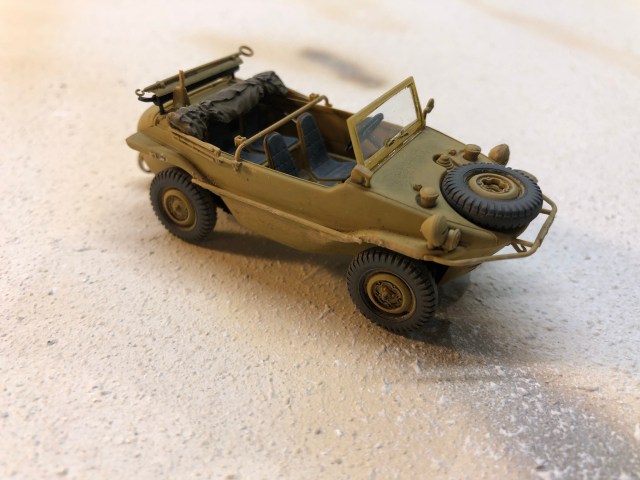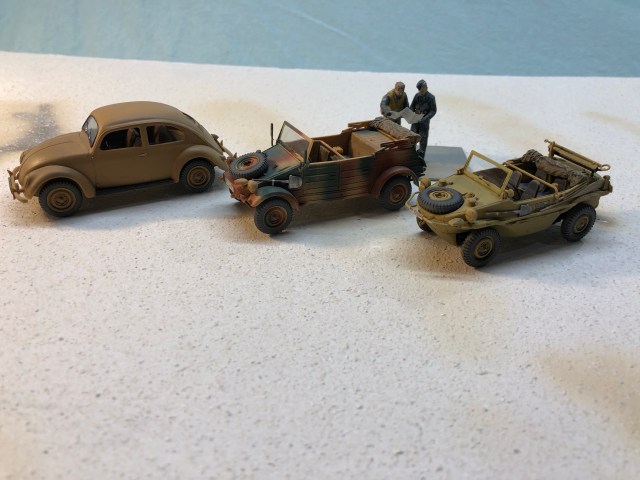This distinctive German car was the most produced amphibious vehicle in history with over 14000 being built.

Let’s take a brief look.
Obviously this is not quite Naval hardware, but armies have long been interested in amphibious vehicles and transports, especially in Europe where rivers and small lakes are regular features of the landscape. And although Germany never had a really successful amphibious truck (like the American DUKW), they led the pack with this swimming 4 wheel drive car (the American “amphibious Jeep” was held in much lower regard).

The propeller is in its lowered position. It would be pulled up against the trunk for overland travel.
The Schwimmwagon was developed from the Volkswagon Beetle. That vehicle had already been militarized into the 4 wheel drive Type 86 Kubelwagon. Ferdinand Porsche foresaw the need for an amphibious version. Obviously the body had to be completely re-engineered, and the first attempt was not wholly successful. On the same wheel base as the Kubelwagon it simply had too much flex which compromised water tight integrity. So a slightly smaller version, the Type 166 would enter full production.
It was 4 wheel drive only in first gear and reverse, but could drive about 50 mph on roads or 6 knots in the water. Water propulsion came from the stern mounted propeller that was stored up against the trunk lid when driving on land. It was driven by a direct linkage to the main engine which meant it only had straight ahead thrust. The front wheels worked as rudders.

Oar attached to the hull is old fashioned emergency propulsion. One problem with such a tiny kit, the photo is zoomed in WAY to close for my comfort!
Production ran from 1941-44 and the vehicle was popular within the army.

Very basic interior.

This is the Tamiya kit. As is common with these smaller models it was fiddly in places, but overall well engineered and presented no major problems.

Progression of the design. The VW Beetle was developed into the military 4×4 Kubelwagon, which was then heavily re-engineered as the Schwimmwagon.
~ Dave

Love the Schwimmwagon, yours looks great! If I could own any military softskin, that would be at the top of my list.
Thank you Jeff. I tried to photograph to hide certain more obvious flaws!
No doubt it could be very useful, but I do prefer something a little faster…
In WWII Stars and Stripes cartoonist Bill Mauldin had one of the amphibious jeeps for a period of time. In his telling the only positive feature was that the weight of the hull kept it from bouncing around like a regular jeep.
Yeah I don’t know much about it, except it was not well liked. From looking at it I would guess underpowered and clumsy. Of course, I might guess something similar about the DUKW, yet it managed to be indispensable.
The Schwimmwagon at least seemed to be adequately utilitarian. Although interestingly it also didn’t really survive into the post-war era.
Early versions of the DUKW were not great. They required crews to regularly change tire pressure manually depending on the terrain and after exiting the water. Once these requirements were automated it became a very versatile and valuable vehicle.
I can’t imagine thinking it was a good idea for crews to have to fuss with that!
Yeah, it was initially pretty limited to transport. Later versions could operate in more hostile environments, but that wasn’t really it’s role.
Obviously all amphibious vehicles will be pretty fragile; thin skinned, weight critical, and water tight. The LVT family of vehicles are the only real exception I can think of. Unless maybe the Russians had something similar?
But I know I’ve read that it was pretty typical that after amphibious assaults anything that operated inland from the beach required a bit of work before it could be considered water ready again.
In the early 70.s there was an effort to market the Volkswagen “The Thing”, essentially a WWII German version of the Jeep. I also have a faint memory of a similar effort for this vehicle, though I may be mistaken.
Yes, the Kubelwagon. Although that was actually the post-war Kubelwagon, presumably a little more street legal than the wartime version. No doubt they were trying for the same success Willys-Overland was having with their civilian models.
I believe it has some value among VW enthusiasts, but is not otherwise highly valued as an antique.
But it would have been a hoot to see a civilian Schwimmwagon. Maybe it could have done better than the Amphicar!